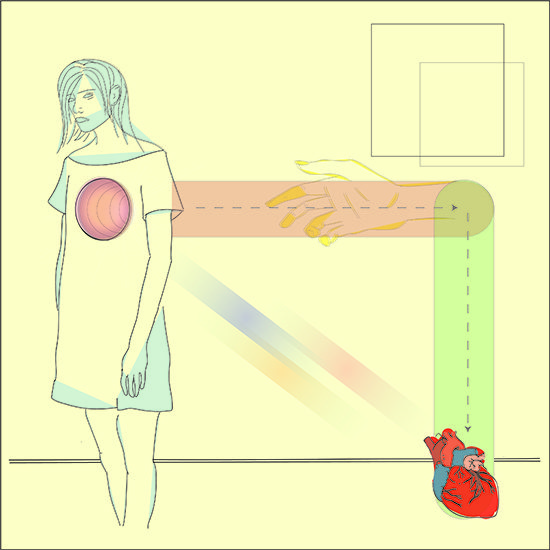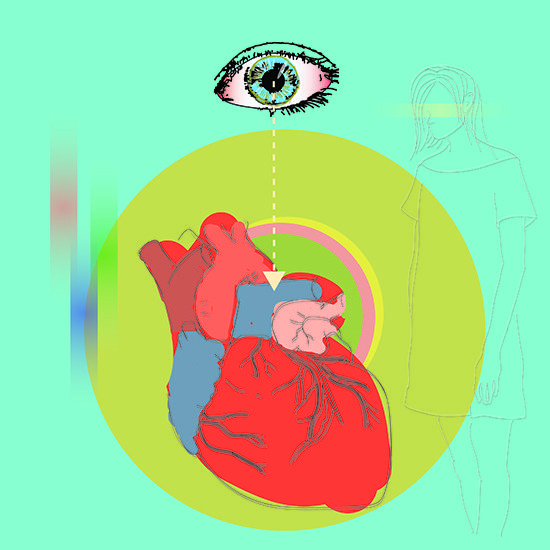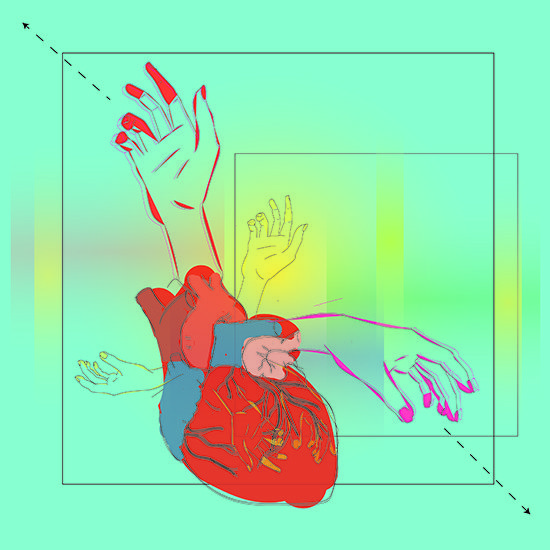The valentine cards have it wrong. The heart is a misshapen potato, a red potato if you like, sitting just left of center, ahead of the scapula, caged in by protective ribs.
It’s a muscle. Four chambers beating together, like a small VW engine. The vena cava delivers oxygen-depleted blood from the body to the right atrium. The tricuspid valve opens, and blood enters the right ventricle, pumped up and out through the pulmonary artery to the lungs. Pulmonary veins carry oxygenated blood back to the left atrium while the mitral valve opens permitting blood to enter the great pumping chamber, the left ventricle. The left ventricle forces nutrient-rich blood through the aortic valve, into the aorta, and out through the arteries into the capillaries feeding the body, before it comes back via the venous highways and byways to the right atria before squeezing through the tricuspid valve back out to the lungs to pick up the next batch of oxygen to bring back into the heart and the beat goes on.
The heart is a resilient muscle. This muscle at the center of life-giving blood flow relies on arteries, to move the gallon and a half, give or take, of liquid coursing through the body each day. It beats on average seventy times a minute; 4,200 times an hour; 108,000 times each day; nearly 37,000,000 times each year. Faster when we’re scared or amped up, slower when we rest. If the average lifespan is roughly 76 years, then that one muscle, the size of a fist, beats 2,796,192,000 times. It never quits, until it quits.
In utero, perhaps the most significant moment of gestation is when expecting parents hear their baby’s heartbeat. The abstract becomes real. The end result of that romp in the sack is, in fact, developing a heart, and it’s loud enough to hear, like the sloshing lub-dub of a washing machine agitator.
Studies show that infants, just a day old, already know their mothers based on the rhythm of her heartbeat, her voice, her scent. The newborn can easily identify her own mother from a lineup of women.
The mother-baby bond continues after birth. They are one being in two bodies, oxytocin and dopamine flooding the mother’s system so she becomes, in fact, addicted to her tiny, needy offspring. There is no greater trauma to mother or infant than severing that bond, those heartstrings.
I was born broken-hearted. At nineteen, my mother left home to stay with her grandmother until she began to show, and then checked into the Florence Crittenton Home for Unwed Mothers. She donned a fake gold band so when she went out the locals would think she was married. I doubt the ring fooled anyone then. When it came time to deliver, the obstetric nurses knocked her out, as was custom in those days. She never saw me; no nurse placed me on her belly after I emerged from the dark sea of amniotic fluid and wailed my first breath. The nurses whisked me away, cleaned me up, and took the obligatory hospital picture. I left the hospital with foster parents.

Even now, as I think about that newborn, I wonder whether she knew she had somehow missed a beat, that when she wasn’t paying attention, she was amputated from the mother she expected to meet. Babies know their mothers by smell, by sound. Did this one know something was amiss?
Three arteries feed the heart: the right coronary artery; the left coronary artery; and its main trunk, the left anterior descending artery. The LAD has an alias: the widow maker. When I was twenty-four, I’d gone to the hospital seeking treatment for back pain and produced the EKG of a fifty-five-year-old male smoker. The doctors were stymied—healthy twenty-four-year-olds don’t have heart attacks. And yet, I had in fact, had a heart attack which prompted the question, “Is there a family history of heart disease?”
No. I’m adopted.
I’ve never not known I was adopted. What I didn’t know was if this was genetic. If there really was something wrong. If your child cries in pain a continent away, does your heart break too? Did her heart ever break for mine?
I’d first written to the state of Ohio when I was nineteen, asking about my birth certificate. Ohio decided I was not entitled to it until I was twenty-one, and not even then. After the heart attack, I made phone calls to people in bureaus of vital statistics. This was the early days of the internet. No Facebook or Instagram to grease the wheels of a missing persons search, but plenty of AOL and UseNet groups. I became my own private detective, picking the brains of librarians steeped in genealogy and emailing with distant cousins who were “not interested in finding anyone’s parents.” I stumbled across the Social Security Death Index and looked up all grandparents I knew about. I spoke to the Director of the Bureau of Social Services in Columbus, searching for the records for the Crittenden Home in Akron. I learned about the birth index, and discovered 61 babies born on November 30, 1966, in Summit County, Ohio. Thirty of them were boys—the rest, girls. Twenty-seven had first names and last names that did not match their mother’s maiden names. Three of them had no first name, and their last names were the same as their unwed mother’s maiden names. One of those three babies was me.
A heart attack happens when the cardiac muscle is deprived of oxygen. No matter how well the heart functions, lack of oxygen leads to ischemic heart disease. Muscles deprived of oxygen die, leaving behind scar tissue. After the hospital experience, the cardiac patient becomes highly attuned and cognizant of her body, the subtle signs of adrenaline causing a sudden blood pressure spike, the staccato flutter of arrhythmia as the heart races, then the crash back into normal sinus rhythm. Scar tissue began to form on my heart the moment I was born.
To diagnose my heart trouble and find the reason for this unusual EKG, I underwent the first of many angiograms. The surgeon cut a small opening in my groin to thread a catheter into my femoral artery and into the heart itself, looking for blood clots or plaque coating the insides of my arteries like sludge coating the pipes under the sink. There was no clot. There was no plaque.
“Your arteries are . . . pristine,” the cardiologist said. “You’ve had a dissection,” Dr. Gordon said, “you seem to have a kind of tear.” He seemed genuinely perplexed by both my youth and my extremely rare condition. No aneurysm, just a rupture within the arterial wall, leaving me with scar tissue over the lower third of my heart, across the septum and much of the left ventricle. The spontaneous dissection functioned just like a clot, except there was no repair for a torn cardiac artery. There was no fix for my heart, not yet anyway.
Like many adoptees searching for their birth parents, I enlisted the help of a Search Angel. After a dozen years of phone calls to libraries and bureaucratic offices, scrutinizing public records . . . I got the call I’d been waiting for.
“It is her,” my Angel confirmed. “She is your birth mother, and she sounds just like you.”
“What did she say?”
“I asked if this was Jo Dennis, and if she was familiar with any Luzader relatives in Ohio. She said she had lots of family records, but no relations in Ohio. I mentioned your birthday and she was quiet for a long time. Then she said, ‘I know what this phone call is about.’ That’s when I said, ‘I’m calling on behalf of your daughter, Debbie Oakeson, born November 30, 1966, in Akron, Ohio. She lives in the Bay Area, in California. She’s been looking for you.’”
There was good news and there was bad news. While Jo confirmed she was my mother, she also confirmed she was not looking for me and did not particularly want to be found. The heart breaks in a thousand different ways.
I spent the next three days shopping for stationery to write the letter I’d been planning to write my entire life. The first draft was thirty-three pages. I edited it down to two, in my very best cursive. An email arrived at work one day, three or four weeks later. From the Parkersburg Public Library. From Jo Dennis. From her.
“I’ve received your lovely letter. I will write when I have a chance to compose my thoughts.” One line. A lifeline. My lifeline. My heart stopped again.
Despite her promise to write, she didn’t. I asked a few questions about family health, and she later sent an encouraging email as I started my first year of teaching. She simply was not ready. She had not prepared. She, too, believed the social workers who said, “She’ll never be able to find you. They’ll never know who you are.”
The heart is a resilient muscle, and the arteries send out new shoots when cardiac tissue dies to feed the viable cardiac tissue caught in and amongst the scarring. These arterioles appear like fingers reaching around and across and into areas that still need oxygenated blood. Doctors know what causes angiogenesis, but they can’t cause it. If they could bottle it, we could end heart disease. Angiogenesis, or to translate the Latin, new arterial beginnings, allows the damaged heart to compensate so cardiac patients can resume their normal lives.
“Roche Pharma, this is Debbie,” I said into the phone, irritated that anyone would call before I had my coffee.
The man on the other end stumbled over my name, “May I speak to Deb . . . Deborah?”
“This is she.” No one calls me Deborah.
“May I speak to Debbie Oakoresk . . . Oakeson?”
“Speaking.” What was wrong with this guy?
“This is Steve Koreski.”
Sharp intake of breath, my heart in my throat, as I whisper, “Oh. My. God. I know who you are. I know who I think you are.”
I don’t realize I’ve said this out loud, but he replied in a soothing Appalachian drawl evocative of the Midwest sliding into the South, “I know everything,” he said, “Where ya been, girl?”

I’d discovered my father’s name through the magic of the early internet a few years prior. Steve Koreski was a PGA golf professional in West Virginia. I wasn’t sure if he knew he had a daughter, let alone if he knew that daughter was me. I’d never given him much thought, or perhaps I was afraid to. While I thought of my birth mother frequently, my birth father was just a shadow. I thought about writing a letter, but how does one write a letter identifying themselves as a long-lost daughter? So, I didn’t.
After that phone call, I was able to spend the following summer learning to play golf and visiting with Steve’s family, my family. He’d spent the better part of that July talking with my birth mother, trying to open the communication artery. He’d given her an ultimatum. Then at dinner one night toward the end of my summer visit to West Virginia, he looked at me and said, “Someone wants to meet you. She wants to meet you. We’re having lunch on Monday.”
We met at the old LaFayette Hotel in Marietta, across the river from West Virginia in Ohio. I recognized her immediately despite never seeing a color picture of her, or even one taken after she was twenty. She sat alone in the elegant lobby, a little dark-haired woman sitting in an overstuffed Queen Anne armchair, red sweater, big blue eyes, and the whole lower half of my face looking back at me. All I heard was the incessant bassline of my heart in my ears.
“Mrs. Dennis?” I queried tentatively. I didn’t know her. I didn’t want to presume or call her Jo or Jody or even Joellen. I was certainly not going to call her “Mom.”
My parents. I was at lunch with my parents. My father carried the conversational load as they reminisced and talked about their parents, siblings, children, and mutual friends. He ever so gingerly brought me out of my silence and into the conversation.
She and I stood on the banks of the Ohio River after lunch, looking back into West Virginia where we were from, the heart of Appalachia. I was a graft onto a different family tree, that much was clear, but I was so very much her. “You are everything I hoped you’d become,” she said.
I stood and watched her walk up the hill to her car, wondering if my heart would ever heal from this moment, this event, this heartwarming tale of high school sweethearts torn apart, and their baby girl, all grown up, returning home to fill the hole in her own heart.




